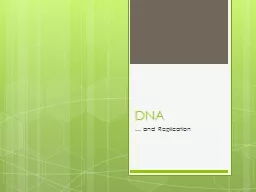

DNA DNA is often called the blueprint of life It contains the instructions for making proteins within the cell Full name deoxyribonucleic acid Why do we study DNA Its central importance to life on earth ID: 565726
Download Presentation The PPT/PDF document "DNA … and Replication" is the property of its rightful owner. Permission is granted to download and print the materials on this web site for personal, non-commercial use only, and to display it on your personal computer provided you do not modify the materials and that you retain all copyright notices contained in the materials. By downloading content from our website, you accept the terms of this agreement.
Slide1
DNA
… and ReplicationSlide2
DNA
DNA is often called the blueprint of life
It contains the instructions for making proteins within the cell
Full name: deoxyribonucleic acidSlide3
Why do we study DNA?
It’s central importance to life on earth
Medical benefits – cures for diseases
Better food cropsSlide4
Shape
DNA is a very long polymer
It’s basic shape is like a twisted ladder or zipper
This is called a double helixSlide5
Nucleotides
DNA is a polymer made up of smaller monomers called
nucleotides
Each nucleotide contains a
phosphate group
,
a
deoxyribose
sugar
and a
nitrogen baseSlide6
Nitrogenous bases
DNA has 4 nitrogen bases:
Adenine (A)
Thymine (T)
Cytosine (C)
Guanine (G)
The bases are specifically paired:
Adenine – thymine
Guanine – cytosineSlide7
Base pairings
The nitrogen bases are attracted to each other through hydrogen bonds
Hydrogen bonds are weak but there are millions of them in a single DNA moleculeSlide8
CHECKPOINT
Thumbs up = true, thumbs down = false
Each nucleotide consists of a phosphate, nitrogen base and a protein
1 DNA molecule = 1 nucleotide
There are 2 strands in each DNA molecule which are held together by hydrogen bonds between the nitrogen basesSlide9
CHECKPOINT
Hold up 1, 2, 3 or 4 fingers:
In a DNA molecule, cytosine always pairs with
1- Itself (Cytosine)
2- Guanine
3- Thymine
4- AdenineSlide10
The Code of Life…
The “code” of a gene on a chromosome comes from the specific order of the bases in the gene
A T C G T A T G C G
G
…Slide11
DNA Replication
DNA must be replicated or copied before a cells divides
This happens during S (synthesis) phase of
interphase
The DNA molecule produces 2 identical new complimentary strands following the base pairing rules (A-T & C-G)
Each strand of original DNA serves as a template for the new strandSlide12
Replication process
An enzyme called
helicase
unwinds and separates (unzips) the 2 DNA strands by breaking the hydrogen bonds between the basesSlide13
Replication
Another enzyme called DNA polymerase adds complementary nucleotides to each original strand
This enzyme initially makes about 1 in 10,000 base pairing errors
Other enzymes come through and proof read & correct these errors
1 in 1 billion errors after proofreading
http://
www.pbs.org/wgbh/aso/tryit/dna/shockwave.htmlSlide14
Replication
Semi-conservative theory:
The 2 strands of the parental (original) DNA molecule separate and each functions as a template for synthesis of a new complimentary strand
Half of the original strand is savedSlide15
CHECKPOINT
What is the name of the enzyme that unzips the DNA molecule?
What is the name of the enzyme that adds new nucleotides to the template strand?
Why is DNA replication referred to as “semi-conservative”?Slide16
RNA – Ribonucleic acid
Responsible for the movement of genetic information from the DNA in
the nucleus
to
the ribosomes (site
of protein
synthesis)
in the
cytoplasm
Structure of RNA:
Made
of repeating
nucleotides
Single-stranded
Differences from DNA:
1
. Sugar – ribose
2
. Nitrogen base – there is NO thymine, RNA has
uracil
instead which
then pairs
with adenineSlide17
Types of RNA
1
. Messenger RNA (mRNA
):
Carries
genetic information from DNA in the nucleus to the cytosol
2. Transfer RNA (
tRNA
):
Takes
amino acids from cytosol to the ribosomes
3. Ribosomal RNA (
rRNA
):
Makes
ribosomes where proteins are made
**
Bellringer
- Copy this slide down on to Pg. 29 of your notebook (under the notes sheet from yesterday)**